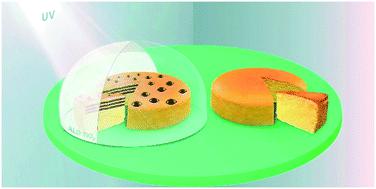当前位置:
X-MOL 学术
›
Catal. Sci. Technol.
›
论文详情
Our official English website, www.x-mol.net, welcomes your
feedback! (Note: you will need to create a separate account there.)
Covalent graphite modification by low-temperature photocatalytic oxidation using a titanium dioxide thin film prepared by atomic layer deposition
Catalysis Science & Technology ( IF 4.4 ) Pub Date : 2021-09-03 , DOI: 10.1039/d1cy00941a Niels R. Ostyn 1 , Sreeprasanth Pulinthanathu Sree 1 , Jin Li 2 , Ji-Yu Feng 2 , Maarten B. J. Roeffaers 3 , Steven De Feyter 4 , Jolien Dendooven 2 , Christophe Detavernier 2 , Johan A. Martens 1
Catalysis Science & Technology ( IF 4.4 ) Pub Date : 2021-09-03 , DOI: 10.1039/d1cy00941a Niels R. Ostyn 1 , Sreeprasanth Pulinthanathu Sree 1 , Jin Li 2 , Ji-Yu Feng 2 , Maarten B. J. Roeffaers 3 , Steven De Feyter 4 , Jolien Dendooven 2 , Christophe Detavernier 2 , Johan A. Martens 1
Affiliation

|
Oxidative modification of graphene-based materials is an attractive route to functional materials. The use of strong oxidants to achieve surface modification of the carbon often leads to poor uniformity and limited reproducibility. Photocatalytic oxidation is a milder method. In this work, graphite is surface oxidized using an anatase thin photocatalytic film with a thickness of 22.5 nm facing the graphite surface to be oxidized. The high UV light transparency (95%) of the supported titania film simplified the experimental setup. The titania thin film was prepared using atomic layer deposition (ALD). Excellent oxidation uniformity and reaction reproducibility are achieved. By avoiding the use of chemical reagents there is no chemical contamination. Graphite photo-oxidation with the titania film prepared with ALD is much faster than with a powdery photocatalyst. The photocatalytic process runs efficiently with air containing water vapor. High resolution scanning electron microscopy (HRSEM), Raman and X-ray photoelectron spectroscopy (XPS) and atomic force microscopy (AFM) confirmed the formation of hydroxyl, epoxy and carbonyl functional groups. ALD is a suitable method for thin film preparation rendering this photocatalytic process suitable for scale-up and automation. Photocatalytically oxidized graphite (POG) electrodes are a potential application.
中文翻译:

使用原子层沉积制备的二氧化钛薄膜通过低温光催化氧化共价石墨改性
石墨烯基材料的氧化改性是功能材料的一条有吸引力的途径。使用强氧化剂来实现碳的表面改性通常会导致均匀性差和重现性有限。光催化氧化是一种较温和的方法。在这项工作中,石墨表面氧化使用锐钛矿薄光催化膜,厚度为 22.5 nm,面向待氧化的石墨表面。支持的二氧化钛薄膜的高紫外线透明度 (95%) 简化了实验设置。使用原子层沉积(ALD)制备二氧化钛薄膜。实现了优异的氧化均匀性和反应重现性。通过避免使用化学试剂,没有化学污染。使用 ALD 制备的二氧化钛薄膜进行石墨光氧化比使用粉状光催化剂快得多。光催化过程在含有水蒸气的空气中有效运行。高分辨率扫描电子显微镜 (HRSEM)、拉曼和 X 射线光电子能谱 (XPS) 和原子力显微镜 (AFM) 证实了羟基、环氧基和羰基官能团的形成。ALD 是一种合适的薄膜制备方法,使这种光催化过程适用于放大和自动化。光催化氧化石墨(POG)电极是一种潜在的应用。拉曼和 X 射线光电子能谱 (XPS) 和原子力显微镜 (AFM) 证实了羟基、环氧基和羰基官能团的形成。ALD 是一种合适的薄膜制备方法,使这种光催化过程适用于放大和自动化。光催化氧化石墨(POG)电极是一种潜在的应用。拉曼和 X 射线光电子能谱 (XPS) 和原子力显微镜 (AFM) 证实了羟基、环氧基和羰基官能团的形成。ALD 是一种合适的薄膜制备方法,使这种光催化过程适用于放大和自动化。光催化氧化石墨(POG)电极是一种潜在的应用。
更新日期:2021-09-16
中文翻译:

使用原子层沉积制备的二氧化钛薄膜通过低温光催化氧化共价石墨改性
石墨烯基材料的氧化改性是功能材料的一条有吸引力的途径。使用强氧化剂来实现碳的表面改性通常会导致均匀性差和重现性有限。光催化氧化是一种较温和的方法。在这项工作中,石墨表面氧化使用锐钛矿薄光催化膜,厚度为 22.5 nm,面向待氧化的石墨表面。支持的二氧化钛薄膜的高紫外线透明度 (95%) 简化了实验设置。使用原子层沉积(ALD)制备二氧化钛薄膜。实现了优异的氧化均匀性和反应重现性。通过避免使用化学试剂,没有化学污染。使用 ALD 制备的二氧化钛薄膜进行石墨光氧化比使用粉状光催化剂快得多。光催化过程在含有水蒸气的空气中有效运行。高分辨率扫描电子显微镜 (HRSEM)、拉曼和 X 射线光电子能谱 (XPS) 和原子力显微镜 (AFM) 证实了羟基、环氧基和羰基官能团的形成。ALD 是一种合适的薄膜制备方法,使这种光催化过程适用于放大和自动化。光催化氧化石墨(POG)电极是一种潜在的应用。拉曼和 X 射线光电子能谱 (XPS) 和原子力显微镜 (AFM) 证实了羟基、环氧基和羰基官能团的形成。ALD 是一种合适的薄膜制备方法,使这种光催化过程适用于放大和自动化。光催化氧化石墨(POG)电极是一种潜在的应用。拉曼和 X 射线光电子能谱 (XPS) 和原子力显微镜 (AFM) 证实了羟基、环氧基和羰基官能团的形成。ALD 是一种合适的薄膜制备方法,使这种光催化过程适用于放大和自动化。光催化氧化石墨(POG)电极是一种潜在的应用。











































 京公网安备 11010802027423号
京公网安备 11010802027423号